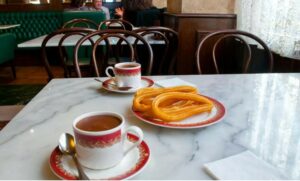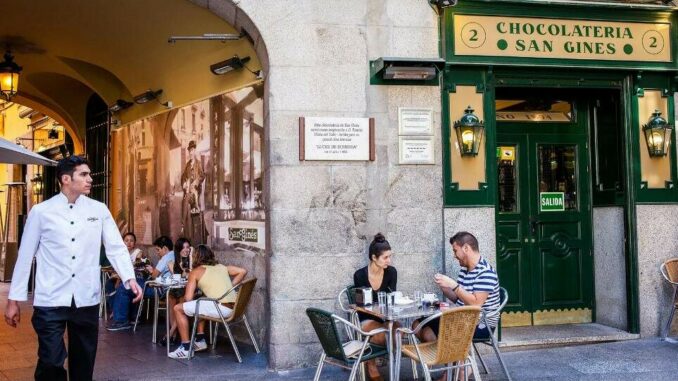 Of all the foods that transform into something sublime after submersion in hot oil, dough, I humbly submit, reigns supreme. At the very least it wins the dramatic-metamorphosis category. Let’s consider the evidence. You take two of the dullest ingredients in the history of cuisine – flour and water – and mix them together. The result is a pale, flabby, sticky, utterly unappetizing blob. But once it plunges into a vat of shimmering-hot oil and slowly rises back to the top, bobbing in a fury of bubbles and steam, the princess has kissed the frog and it becomes a golden, crispy, chewy thing of deliciousness. A churro.
Of all the foods that transform into something sublime after submersion in hot oil, dough, I humbly submit, reigns supreme. At the very least it wins the dramatic-metamorphosis category. Let’s consider the evidence. You take two of the dullest ingredients in the history of cuisine – flour and water – and mix them together. The result is a pale, flabby, sticky, utterly unappetizing blob. But once it plunges into a vat of shimmering-hot oil and slowly rises back to the top, bobbing in a fury of bubbles and steam, the princess has kissed the frog and it becomes a golden, crispy, chewy thing of deliciousness. A churro. My theory is that the key to the churro’s popularity is its shape. The churro is to dough what the French fry is to potatoes. An authentic Spanish churro is thin and needs to be piped through a star-shaped funnel tip. That way, the ridges get crispier than the rest, and the full gamut between crunch and chew can be appreciated by the mindful. The shape also has other things to recommend it. A doughnut bumps into your cheeks but a churro is easier to eat, which may explain in part why they’re so popular as a walk-around treat at fairs and amusement parks.
My theory is that the key to the churro’s popularity is its shape. The churro is to dough what the French fry is to potatoes. An authentic Spanish churro is thin and needs to be piped through a star-shaped funnel tip. That way, the ridges get crispier than the rest, and the full gamut between crunch and chew can be appreciated by the mindful. The shape also has other things to recommend it. A doughnut bumps into your cheeks but a churro is easier to eat, which may explain in part why they’re so popular as a walk-around treat at fairs and amusement parks.
referring to a popular breakfast fritter in China, usually dipped in soya milk or rice congee.
Is it a case of coevolution? Or did the humble but venerated churro, the pride of Spain’s contribution to world pastries, evolve from a Chinese youtiao? Maybe Portuguese sailors brought it back from China to the Iberian Peninsula? Or do you believe the Spanish, who say shepherds invented it out of a need to make some simple, filling food while roaming the mountains where they couldn’t bake bread?
Fried dough in Spain is a lot older than that. Recipes from Moorish Spain date from the 12th Century, and other Arabic sources date back to the 8th and 9th Centuries, leading some to credit the Arabs for introducing it to what was then not even known as Spain.
But we’re not done yet. “In some ways,” said food historian Michael Kondl, “today’s churro is not that different from a recipe for a flour and water fritter that you find in Apicius, a Roman cookbook dating from the 1st Century AD. And there are recipes from the Ancient Greeks but it’s probably even older than that. In the Mediterranean basin it’s basically been around forever.”
While churros have been eaten in Spain for centuries, the word itself, most likely a reference to the curly horns of the Churra sheep, doesn’t appear in written sources until the late 19th Century. That’s also when Madrid’s famous Chocolatería San Ginés opened and started serving churros and mugs of thick, dark chocolate.

On a normal day, Daniel Real, the master churrero at San Ginés, says they can go through 80,000 to 90,000 churros a day.
During the 16th century, Spanish explorers brought churros to every port of the new world. Lucky us!
Churros recipe
1 c. water
1 c. flour
Pinch of salt
Add a pinch of salt to one cup of water and bring to a boil. Just before it boils, add one cup of flour all at once and stir enthusiastically with a wooden spoon. Take off the heat. Keep stirring until the dough comes away from the sides. Add a little flour if too sticky, then form into a ball and set aside for 10 minutes.
Meanwhile, bring the oil to 185°C. You can either squeeze out the churros onto a lightly floured surface before frying or place them right into the hot oil, snipping them with scissors as you go. Churros will float, but they need to be turned halfway through frying.
Fry until golden brown. Remove from oil and sprinkle with table sugar while still hot.

Leave a Reply